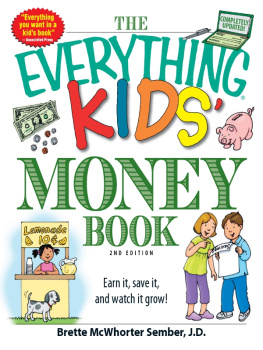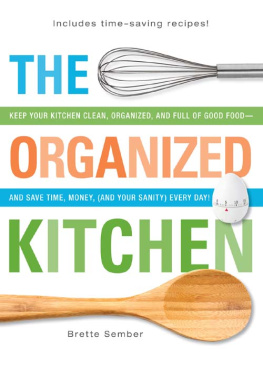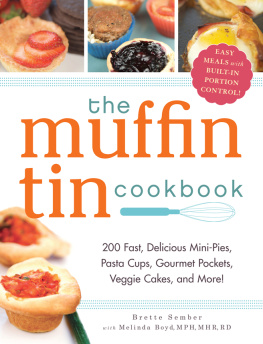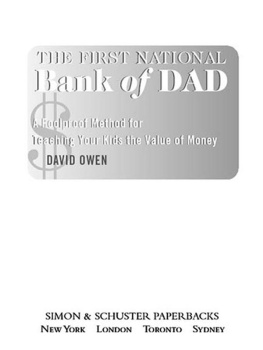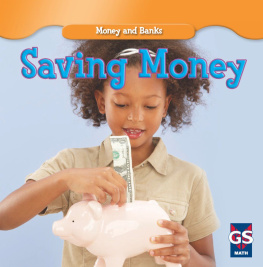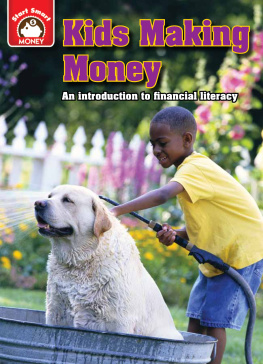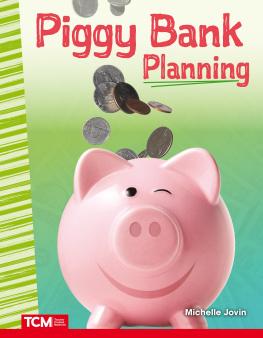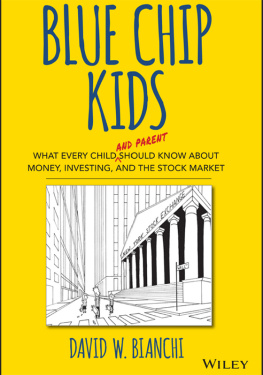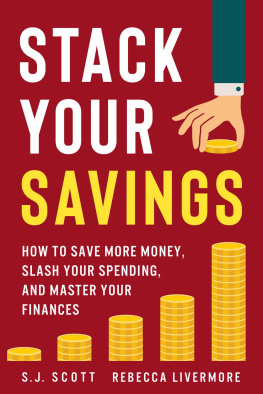
Earn it, save it, and watch it grow!
Brette McWhorter Sember, J.D.

PUBLISHER Karen Cooper
DIRECTOR OF ACQUISITIONS AND INNOVATION Paula Munier
MANAGING EDITOR,EVERYTHING SERIES Lisa Laing
COPY CHIEF Casey Ebert
ACQUISITIONS EDITOR Katie McDonough
DEVELOPMENT EDITOR Elizabeth Kassab
EDITORIAL ASSISTANT Hillary Thompson
Copyright 2008 by F+W Publications, Inc.
All rights reserved.
This book, or parts thereof, may not be reproduced in any form without permission from the publisher; exceptions are made for brief excerpts used in published reviews and photocopies made for classroom use.
An Everything Series Book.
Everything and everything.com are registered trademarks of F+W Publications, Inc.
Published by Adams Media, an F+W Publications Company
57 Littlefield Street, Avon, MA 02322. U.S.A.
www.adamsmedia.com
ISBN-10: 1-59869-784-6
ISBN-13: 978-1-59869-784-1
eISBN-13: 978-1-60550-776-7
Printed in the United States of America.
J I H G F E D C B A
This publication is designed to provide accurate and authoritative information with regard to the subject matter covered. It is sold with the understanding that the publisher is not engaged in rendering legal, accounting, or other professional advice. If legal advice or other expert assistance is required, the services of a competent professional person should be sought.
From a Declaration of Principles jointly adopted by a Committee of the American Bar Association and a Committee of Publishers and Associations
Many of the designations used by manufacturers and sellers to distinguish their products are claimed as trademarks. When those designations appear in this book and Adams Media was aware of a trademark claim, the designations have been printed with initial capital letters.
Cover illustrations by Dana Regan.
Interior illustrations by Kurt Dolber.
Puzzles by Scot Ritchie.
This book is available at quantity discounts for bulk purchases.
For information, please call 1-800-289-0963.
Visit the entire Everything series at www.everything.com
CONTENTS

Dedication
For Quinne and Zayne. With one who loves to save and one wholoves to spend, I have the best of both worlds!
INTRODUCTION
M oney is an exciting thing that is a huge a part of everyday life for kids and grown-ups. You can save it, earn it, spend it, collect it, or just count it. If youre interested in money, theres a lot you can learn. In fact, theres so much it fills this whole book!
Money has a long, long history. Long before there were bills and coins, people used shells and grain as money. (How much is that? Thatll be three shells. Can you imagine?) This book has lots of cool facts about money all throughout history. Youll also learn how money is made and what all the marks on money mean. Some money is actually worth more than it saysthats why learning about coin collecting is a great way to discover some extra value in your money! Youll discover what the biggest bill ever made in the United States was worth, how to earn virtual money online, and ideas for what to do with your allowance.
Theres more to money than the currency itself, though! Banks, loans, earning money, paying taxes on money, earning interest on money, budgeting, and giving to charity are all super-important ways that money plays a part in your life and the life of your family. Ever wondered how the stock market works? How a bank makes a profit? Have you ever thought about why things cost what they do and why prices go up over time? Were you ever curious about what types of money are used in other countries?
Youre about to learn all of that and tons more, such as ways to earn extra dough, how to use gift cards, how a school debit card works, how credit cards work, and how to open and use a bank account. Being smart about money is not just something adults need to dokids can learn to be wise savers, careful spenders, and smart consumers, too.
Along the way, youll learn neat facts, awesome tricks, and rad things to do with money!

Chapter 1
THE STORY OF
MONEY

PENNY
FOR YOUR
THOUGHTS
Daily Trades
What kinds of trades do you make? You probably make lots of trades without realizing it. If you take out the garbage in order to earn your allowance, youre trading your hard (and smelly!) work for cash. If you buy an action figure at the toy store, you trade dollars for the toy.
TRADE YA!
If youve ever traded the banana from your lunch for someone elses apple, then youve taken part in one of the oldest forms of buying and sellingbartering. Bartering works fairly well as long as the goods being exchanged have the same value, like the apple and the banana. But, what if you wanted to trade a bicycle? How many bananas would equal one bicycle? Probably too many for you to think about without feeling queasy!
How Bartering Worked
Thousands of years ago, people traded with each other on a small scaleone farmers grapes for anothers pumpkins. This worked for a while, but as life became more complex so did the system of bartering. Some people did not farm. They developed other skills such as tool making or basket weaving.
A basket maker may want to buy some grapes, but the farmer already has enough baskets and wont make a trade. A toolmaker needs a basket, so he asks the basket maker to trade for a knife. The basket maker now has a knife that he takes to the farmer to see if the farmer will accept it in exchange for grapes. He will, and the trade is madebut what an uncertain business it is! The poor basket maker could have just as easily ended up without any grapes! And what if the basket maker needed only a few grapes for his lunch? Could the knife have been divided up into smaller pieces? Not if it was to retain its value! Bartering got to be very complicated and time consuming!
BEFORE MONEY THERE WERE COMMODITIES
People needed a better way to do business. Commodity money! Commodity money is when things people commonly had (commodities) were used as money. Barley is an example of a grain that was used for trade. Everyone accepted barley as payment. The basket maker would take barley in return for a basket. The farmer would take the barley for grapes. The toolmaker would take the barley in trade for a knife. Business could be done more efficiently, but people still had to haul big baskets of barley around. Can you imagine if you had to carry a big old basket of barley into the mall to buy something? It wouldnt be easy!

LEGAL TENDER: When a government makes one type of money the official currency of that country, this is called legal tender. The legal tender in the United States is the dollar.
Barley also had its problems. It could spoil or become infested with bugs (eww!). If the barley harvest was poor one year, then there would be very little to use in trade. And there was the problem of transporting it! Another change was needed. Perishable money was replaced by a harder form of money.
Next page
